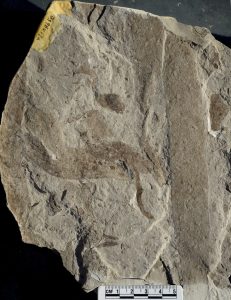
A research group led by Prof. ZHU Maoyan from Nanjing Institute of Geology and Paleontology reported on May 18 in Nature Communications the discovery of macroscopic fossils from the 1,560- million years (Myr)-old Gaoyuzhuang Formation, Yanshan area, North China, that exhibit both large size and regular morphology.
Preserved as carbonaceous compressions, the Gaoyuzhuang fossils have statistically regular linear to lanceolate shapes up to 30 cm long and nearly 8 cm wide, suggesting that the Gaoyuzhuang fossils record benthic multicellular eukaryotes of unprecedentedly large size. The new fossils provide the strongest evidence yet that multicellular eukaryotes with decimetric dimensions and a regular developmental program populated the marine biosphere at least a billion years before the Cambrian Explosion.
The fossils’ morphotypes are linear (elongate with parallel sides, truncated at both ends), cuneate (distinct taper on one end; other end truncated), oblong (rounded on one end) or tongue-shaped (round end, but without parallel sides) and so on. The tongue-shaped fossils are the largest remains in the assemblage, with dimensions up to 28.6 cm by 7.6 cm. The linear fossils are up 22.9 cm long and 4.5 cm wide with ragged ends, suggesting they are fragments of larger individuals.
The linear specimens resemble the distal ends of cuneate compressions, and size frequency distributions for the two morphotypes overlap strongly. The inference of organized multicellularity is reinforced by well-preserved cell sheets in organic fragments extracted from fossiliferous samples by acid maceration.
The Gaoyuzhuang fossils provide the most compelling evidence yet reported that by the beginning of the Mesoproterozoic Era, 1,600 Myr ago, eukaryotic organisms had evolved macroscopic form, multicellularity with limited cell differentiation, and (probably) photosynthesis. If so, their rarity as fossils in pre-Ediacaran (>635 Myr) must reflect processes of preservation rather than simple biological absence. Continuing research promises new insights into marine ecosystems in the low oxygen world caricatured misleadingly as a ‘boring billion’ year interval of evolutionary as well as environmental stability.
This study was supported by the National Natural Science Foundation of China and National Key Basic Research Program of China.
Note: The above post is reprinted from materials provided by Chinese Academy of Sciences.










